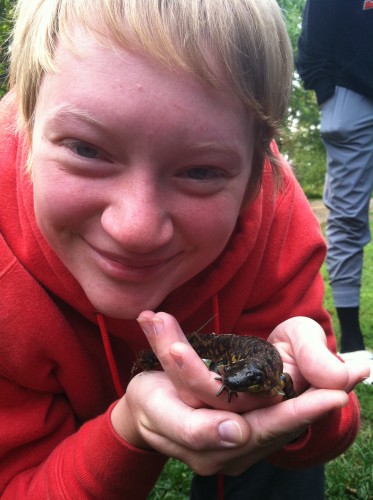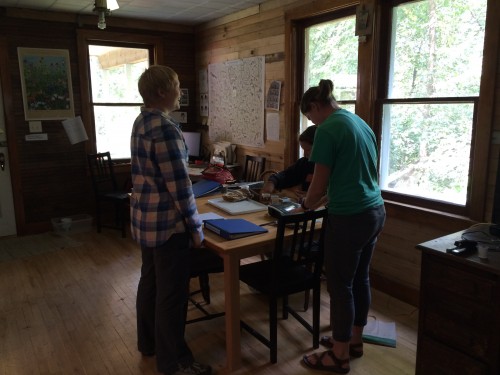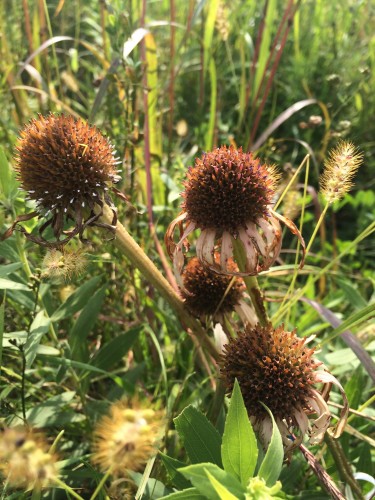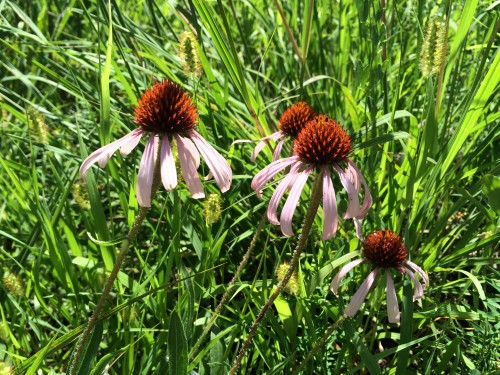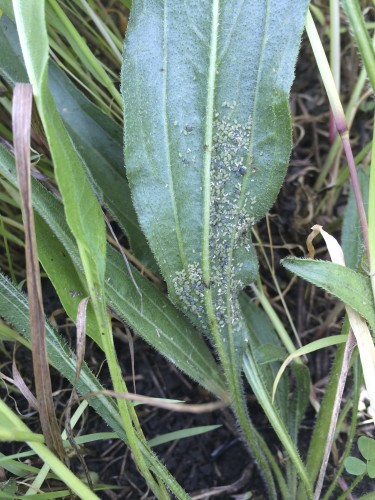|
|
Today marked our third day without Stuart. But our arrival to a Stuart-less Hjelm house was made brighter by the appearance of a tiger salamander! (In Roxy’s absence, we’ve noticed quite a bounty of wildlife roaming the area.) Katherine, who has known since the age of 8 that the majestic and bafflingly cute creature is her favorite animal, was especially excited. After an extended photo op and cuddling session, the team finally managed to set the salamander back down and get on with the day’s work. We all agreed that he was an upgrade from Ricky.
 Katherine holds her first tiger salamander! Obvious soulmates. We spent most of the morning doing demography at the Rileys. Despite some grief and hardship caused by the abundance of mowed plants, we finished strong and well before lunch. Back at the Hjelm house we set to work cleaning and organizing, dealing with clutter that had been neglected for too long. Things got really exciting when Amy dug out the label maker. We spent lunch dreaming up big plans to label everything in the Hjelm house–in between fighting off the hornets.
 The Hjelm house is looking pretty good. After lunch, Will and I collected tissue samples from the Cirsium hillii at Hegg (that will be used to determine if the plants are distinct or actually one large plant) while Abby and Danny collected tissue from the angustifolia plants nearby the pallida restoration. Meanwhile, Katherine, Ali, and Amy stayed back to touch up the paint jobs on the heads for q3.
Our work done at Hegg, we headed back to Hjelm and packed away the tissue samples to dry out. We printed labels for the samples, but unfortunately the label maker ran out of paper before we could get on with the rest of our big labeling plans. Oh well. We’ll have to continue to do our best navigating the house with its very average level of labeling.
 Heads for q3 wait in p1 to be harvested.
While just last Friday we were straining under the heat and humidity and dripping sweat onto our visors as we pushed through field work, today was one of the coldest days of the summer so far and had us bundled up in our flannels, rain coats, and wool socks.
We started off the frigid morning going over the demography protocol before all heading out as a team to Steven’s Approach and Aanenson to give it a try. A newly-organized g3 helped things run smoothly as we got ready to head out. (As promised in yesterday’s post, here’s a picture featuring g3 as it’s never been seen before!)
 Ben revels in the beauty that is g3. Tubs are now labeled and color-coded. Out in the field, Stuart made sure that we got some “active searching” practice as we tried to find plants that had been missed back in the days of phenology (i.e. a couple weeks ago). After just two sites, greying skies, menacing rain, and numb hands sent us back to the Hjelm house just in time for a chilly lunch on the porch featuring steaming mugs of tea and chocolate chip zucchini cookies (baked by Ali and Amy).
 Brrrrr. Warm cups of tea at lunch helped remedy the cold. Note that Danny broke out his hat! The storm picked up in the afternoon and left us stationed at the Hjelm house for the rest of the day getting some computer work done for our independent projects. After a summer spent applying our aphid addition and exclusion treatments, Abby and I were excited to start looking over our data set and get to work analyzing it! More updates to come.
 Ali and Ben take a look at the results of Ben’s seed harvesting out at Hegg Lake.
 Some heads in p1 that are just about done flowering. With so many of our remnant Echinacea done flowering (less than 300 down from the 2,000 we visited at peak!), this past Tuesday found the team with some extra time on their hands. Instead of starting out with phenology, we got a chance to make progress on our independent projects. Abby and I headed out to p1 to spend some time with the specialist aphid, Aphis echinaceae. For the past few weeks we’ve been applying addition and exclusion treatments to 100 study plants in the plot with the goal of understanding some of the effects of the aphid on its host plant–continuing a study that Katherine Muller began a few years back.
The wet and dewy Tuesday morning marked our seventh round of treatments. Since starting out we’ve learned a lot about handling (“herding”) our aphids–how best to coax them from their colonies, how to keep them happy during the move between leaves, how to get them settled on their new leaves. Aphid transferring is a delicate process that requires patience and a loving touch. Offering words of comfort and encouragement seems to help ease the transition for the aphids.
While we started out with a pretty scarce supply of aphids in the garden, only able to add a couple of aphids to each of our plants and struggling to get colonies to establish, we’ve noticed a recent spike in the population. After managing to apply about 10 aphids to each plant in one of our recent treatments, we finally had some successes. On Tuesday, we found about half of our additions plants with small colonies taking hold.
 This collection plant had some of the most aphids we’ve seen yet in one place! Some hypothesize that specialist aphids can have a more positive effect on their hosts as compared to generalist aphids. In just a week or two we’ll start assessing our study plants for fitness characteristics like basal leaf count and length of longest leaf, as well as for patterns in herbivory and senescence, to see if years of these addition and exclusion treatments have impacted the plants. I’m excited to move on to this phase of the research!
 Team Echinacea shows off the many troll-phies and ribbons earned at the Flekke-5k! Today was a winning day for Team Echinacea! Ten members of the crew (including Hattie and Per) got up early to run the 5k at the annual Elbow Lake Scandinavian festival with the catchy name “Flekkefest.” The humidity let up for us and the morning was a cloudless, cool, and crisp one as we assembled for the race. Approaching the registration table we found that Abby’s dad, who was in charge of organizing the race, had made us a “Welcome Team Echinacea” sign. The sign must have been some encouragement; five kilometers later we had quite a few trophies under our belts. Our very own Amy got first place overall for women! Between the rest of us we also earned second and fourth for women, as well as a few wins for our respective age groups. My favorite part about the race was that they gave out troll trophies–which we dubbed “trollphies” for short.
 Amy’s troll-phy for first place! Maybe most exciting of all, however, every participant of the race got a free book coupon for the book sale going on downtown. We spent the next hour after the race finding used book gems (like the ones below), before enjoying an all-you-can-eat breakfast buffet at a small place across the street.
 Some treasures picked up at the Flekkefest used book sale. Home, well-fed, and showered, we proceeded lazily with the rest of the day at Town Hall. Curled up with our new (old) books, a few of us ended up napping–not surprising given that our day started at 6am!
The days and weeks are starting to fly by as we get into the busy part of the summer. Nearing the end of July, it seems like we’re hovering right around the peak of the flowering season for Echinacea angustifolia. In addition to keeping up with the phenology for our flowers (roughly a couple thousand across our remnants alone!), we’re also making timely progress on independent projects and getting important work done on the q3 experiment.
We got off to a quick start this morning sending half the crew out to do phenology at a handful of sites while Danny and Amy continued their work assessing compatibility across remnant flowers and still a few others collected pollen at Staffanson for q3. While phenology is proving to be quite the time commitment right now, we’re slowly (and satisfyingly) starting to be able to check the “Done flowering” box for more and more of our flowers. The flowering season is tapering off much faster than I had expected!
 A cross-pollinator’s eye view of a well-organized team carrying out crosses in p1. The bright and breezy afternoon had most of the team out in p1 doing pollen crosses for q3. Stuart debuted a new system for keeping us organized in the field as we share, swap, switch, and track down the right vials of sire pollen to be applied to the p1 dams. While the fits of wind that persisted for much of the afternoon were a nice way to cool down, it was not very much appreciated when the breeze swept away the valuable bits of pollen we were trying to apply to our flowers!
The day ended with a visit from some of the parents of the crew members and local science teachers (these two groups actually had quite a bit of overlap). These visits were timed excellently for our guests to appreciate the Echinacea in all their peak flowering glory.
 Bagged and painted Echinacea ready to be cross-pollinated.
Flowering Echinacea take no holiday! Half of the Team got up early on this Saturday morning and headed out into the field to make sure we stay on top of the fast-paced world of phenology. With the crew re-assembled back at the Town Hall for the afternoon, the rest of the day proceeded lazily–fitting for the humid weather and the holiday at hand. Munching on the delicious leftovers from yesterday’s picnic, reading, and napping in turn, we passed a couple hours before heading over to Elk Lake once again. (The small lake-side beach has become a favorite haunt for the group!) Lea clearly still had Echinacea on her mind and made this awesome watercolor. (Note the pollen! How long do you think this plant has been flowering?)
 Lea’s watercolor of Echinacea!  Oobleck: one part water, two parts corn starch, one part magic. After returning home we had some old-school, science-themed fun with “oobleck”–a miraculous mix of water and corn starch yielding a substance that’s somehow both a solid and liquid. We finished off the night with a delicious (and festive) s’mores pie baked by Amy.
Happy Fourth of July on behalf of Team Echinacea!
 S’mores pie!
Our second Thursday got off to a strong start as we finished pulling sweet clover from p8. Last night’s rain meant prime clover-pulling conditions: wet and loose soil that allowed us to extract the full tap roots of the tenacious plants from the ground. Danny provided some a cappella background tunes to keep us moving through this herculean task. Despite the wet soil, there were still quite a few plants that were able to put up a good fight. Flexing my sore hands at the end of the hour or so we spent in p8, I relished the sight of all the pulled clover laid out to parch in the sun. P8 is now sweet clover free! (At least for now.)
 The Team lays out sweet clover pulled from p1 to dry in the sun. After pulling the clover we had time before lunch for a lesson in using GPS to map plants and help out with Echinacea demography. Stuart had started the day by checking the space weather–apparently a solar flare just missed us, very luckily leaving us in the clear to proceed with the Team’s two GPS machines (affectionately named Sulu and Chekov).
 Using GPS to stake Echinacea plants! At lunch a few of us gave quick presentations about our summer project proposals, which have already made a lot of progress in the two weeks since we arrived! Some of the questions we’ll be attempting to answer this season include how aphids affect Echinacea fitness, how hybrid and native plants differ in fitness, which seed collecting methods are the most effective for species co-flowering with brome, and whether flowering phenology is heritable. Finally we got the chance to hear from professor Ruth Shaw about some of the latest work being done on analyzing the genetics of fitness in Echinacea (and other species as well!).
After this jam-packed morning, the Team got some down time to work on individual projects. I look forward to watching everyone’s research progress!
Turning right onto Unity Drive from Highway 27 you’ll quickly come upon a small patch of remnant prairie just off the right side of the road. The patch is squeezed in between a tree line and the heavily mowed roadside, and at first glance looks to be primarily invasive grasses. Brome, poa, and Indian grass–all non-native–clearly dominate. And creeping down from the tree line is a fair amount of poison ivy that actually seems to overtake the grasses up closer to the trees. We saw no evidence of the pale and narrow leaves of the Echinacea angustifolia poking up in between the grasses. Slightly disappointed with the apparent lack of diversity and absence of native species in this unassuming roadside patch, we were about to walk away when we spotted the soft metallic green of some leadplants crowning the top of the incline by the tree line. These native legumes are a sign of a healthy prairie, and finding them was without a doubt the redeeming highlight of our encounter with this otherwise sad patch of prairie.
Upon returning to the research base just down the road and showing the picture we took of the site to Stuart, we found out that much of the remnant had very recently been mowed and the patch we were examining was smaller than it had been even since Stuart’s last visit–a disappointing fact added to our investigation. We hope that this ever-shrinking prairie remnant sees better days soon.
 Snapshot of “South of Golf Course” prairie remnant off of Unity Drive and Highway 27.
|
|

